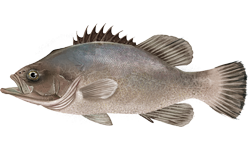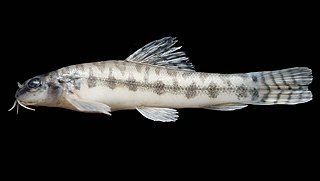
The wreckfish are a small group of ray-finned fish in the genus Polyprion, belonging to the monotypic family Polyprionidae in the order Acropomatiformes.
Acanthocobitis is a genus of freshwater ray-finned fish of the stone loach family, Nemacheilidae. Recent work has suggested that the genus be split into two with the former subgenus Paracanthocobitis being raised to a full species, leaving just the type species, Acanthocobitis pavonacea, in the current genus.

Indoreonectes is a genus of stone loaches native to the Western Ghats in India.
Acanthocobitis pavonacea, also known as the spearfin loach, is a species of ray-finned fish belonging to the family Nemacheilidae, the stone loaches. This species is found in the Brahmaputra River of Assam. This is one of two species in the genus Acanthocobitis, alongside the type species, A. longipinnis. A. longipennis was treated as synonym of this species but in 2021 Maurice Kottelat and Waikhom Vishwanath published a paper that argued that A. longipennis was a valid species and that it was one of two species ofloach in the genus Acanthocobitis, alongside A. pavonacea, with the other species being classified in the genus Paracanthocobitis. This species is the type species of the genus Acanthocobitis.
Hedinichthys minuta is a species of ray-finned fish in the genus Hedinichthys, which is classified in the family Nemacheilidae, the stone loaches. This species is indigenous to Sinkiang but has been introduced elsewhere in northern China.

Micronemacheilus is a genus of freshwater ray-finned fishes belonging to the family Nemacheilidae, the stone loaches. The loaches in this genus are found in eastern Asia.

Nemachilichthys is a monospecific genus of freshwater ray-finned fish belonging to the family Nemacheilidae, the stone loaches. The only species in the genus is Nemachilichthys rueppelli, the mongoose loach or Shimoga loach, a species endemic to the Western Ghats in Karnataka and Maharashtra.
Physoschistura is a genus of fish in the family Nemacheilidae found mostly in Southeast Asia.
Protonemacheilus longipectoralis is a species of hillstream loach that is endemic to China. It is the only species in its genus.

Bangana is a genus of fish in the family Cyprinidae, the carps and minnows. It is distributed across much of southern and eastern Asia. Species live mainly in the flowing waters of tropical and subtropical rivers.

The Nemacheilidae, or stone loaches, are a family of cypriniform fishes that inhabit stream environments, mostly in Eurasia, with one genus, Afronemacheilus found in Africa. The family includes about 790 species.
Eonemachilus is a genus of ray-finned fish belonging to the family Nemacheilidae, the stone loaches. The fishes in this genus are found in China.

Petruichthys is a genus of stone loaches native to eastern Asia. The genus is not universally accepted as valid and the two species placed there have been placed in other genera.
Traccatichthys is a genus of stone loaches from southern China and Vietnam.

Paracanthocobitis is a genus of freshwater ray-finned fishes belonging to the family Nemacheilidae, the stone loaches. This genus is known from the Indus basin in Pakistan to the Mekong basin of Cambodia and Laos The type species is Paracanthocobitis zonalternans. Some authorities treat this as a subgenus of Acanthocobitis
Acanthocobitis longipinnis is a species of freshwater ray-finned fish belonging to the family Nemacheilidae, the stone loaches. This species is known from a single specimen, the holotype, which was collected from the Ganges. This species was first formally described in 1861 by the German naturalist and explorer Wilhelm Peters and Peters proposed the new genus Acanthocobitis. Later authors treated this species as a synonym of Cobitis pavonacea but in 2021 Maurice Kottelat and Waikhom Vishwanath published a paper that argued that A. longipennis was a valid species and that it was one of two species of loach in the genus Acanthocobitis, alongside A. pavonacea, with the other species being classified in the genus Paracanthocobitis. This species is the type species of the genus Acanthocobitis.
Karstinnectes is a genus of freshwater ray-finned fishes belonging to the family Nemacheilidae, the stone loaches. The fishes in this genus are cavefish found in China.
Kayahschistura is a monospecific genus of freshwater ray-finned fish belonging to the family Nemacheilidae, the stone loaches. The only species in the genus is Kayahschistura lokalayensis, a cave fish which is known from two caves in the Hpruso District of the Kayah State in Myanmar.
Malihkaia is a monospecific genus of freshwater ray-finned fish belonging to the family Nemacheilidae, the stone loaches. The only species in the genus is Malihkaia aligera. This species was foirsy formalled described in 2017 by the Swiss ichthyologist Maurice Kottelat with its type locality given as the Mali Hka River, about 9 km upstream of Kang Mu Lon on the Kachin State of Myanmar at 27°25'54"N, 97°27'56"E from an elevation of 402 m (1,319 ft).
Petruichthys salmonides is a little known species of freshwater ray-finned fish belonging to the family Nemacheilidae, the stone loaches. It is known only from the holotype which was collected at "Mongpan" in southern Yunnan and described by B. L. Chaudhuri. It has been considered to be a synonym of Yunnanilus pleurotaenia but Yunnanilus fishes have restricted distributions that are disjunct from the given type locality of this species and Chaudhuri's original description does not match any Yunnanilus species. This species has been regarded as a species inquirenda but Eschmeyer's Catalog of Fishes treats it as a valid recognised species within Petruichthys.







